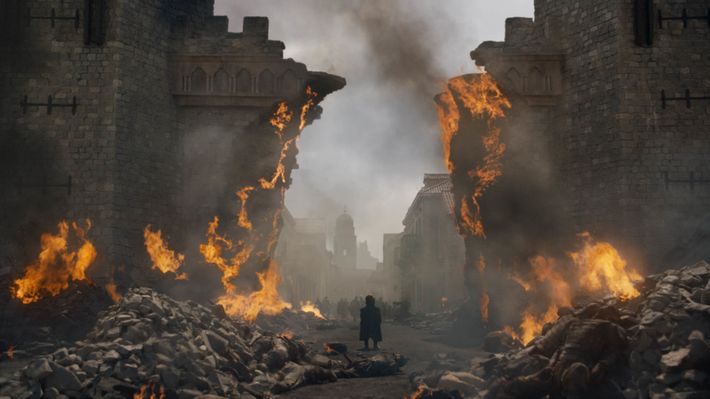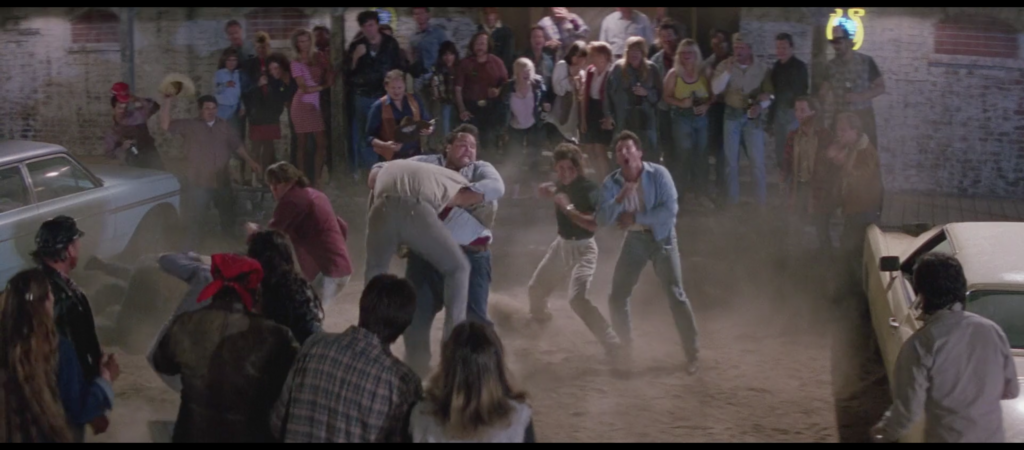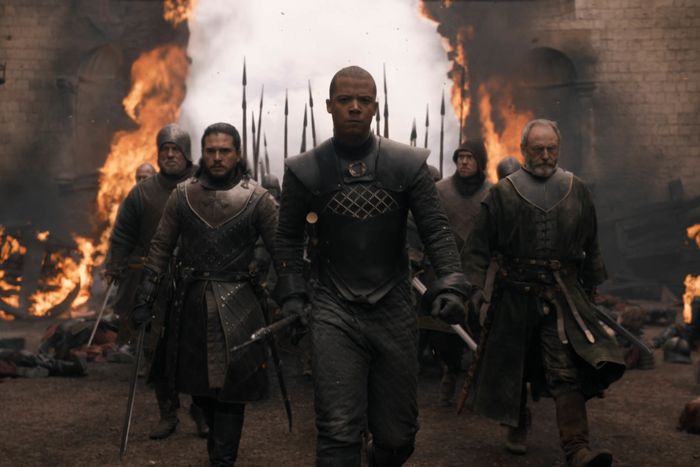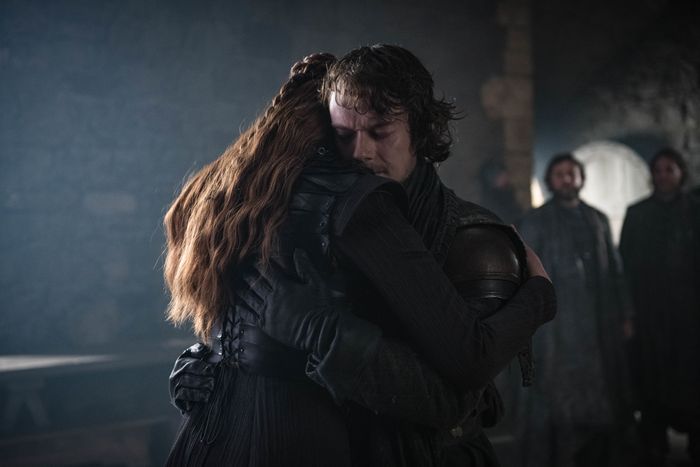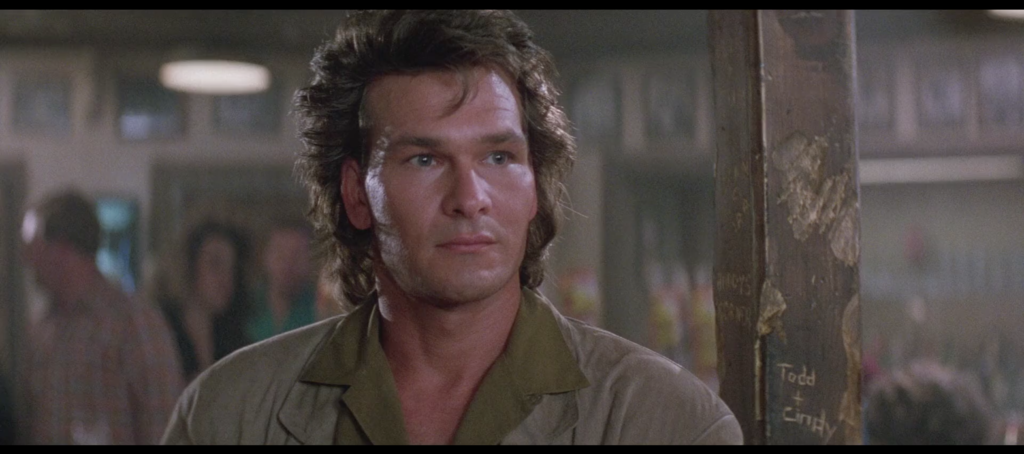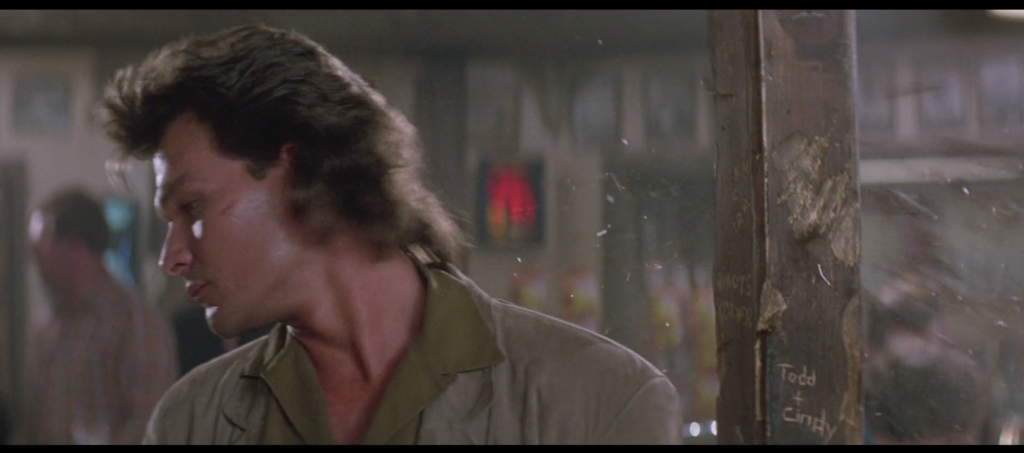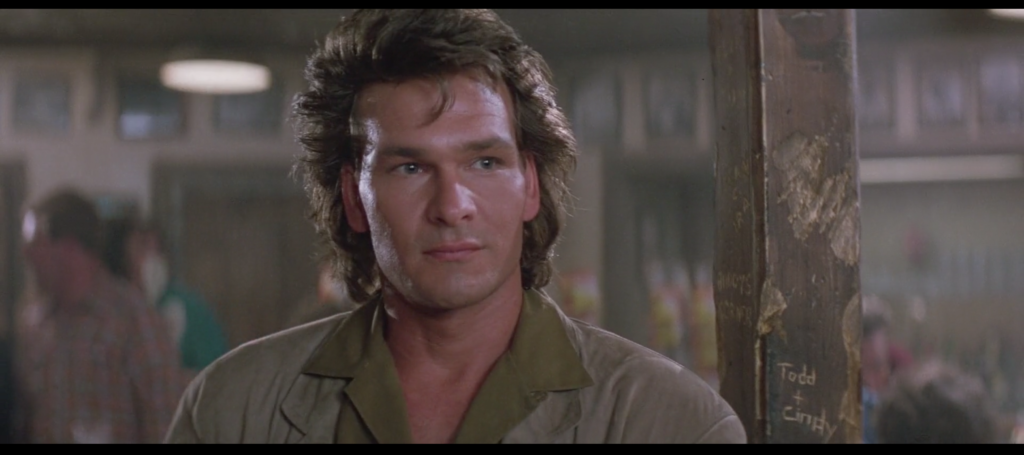Posts Tagged ‘George R.R. Martin’
Every Game of Thrones Episode, Ranked
May 20, 20191. “The Bells” (Season 8, Episode 5)
Sansa Stark: How long do I have to look?
Joffrey Baratheon: As long as it pleases me.Miguel Sapochnik, the man behind “Hardhome,” “Battle of the Bastards,” and “The Long Night,” succeeded Neil Marshall as the show’s master of war. Returning to the director’s chair one last time for the series’s penultimate episode, he turns off the dark that confounded many viewers during the Battle of Winterfell. But does he therefore dial down the carnage that occurs any time large numbers of people decide to murder one another for a cause? Oh, no. Oh, not at all.
“The Bells” ratchets up the queasy terror of the last battle episode set at King’s Landing, “Blackwater,” by making its narrowly averted nightmare come true. This time, instead of stalling at the city walls, the invaders make it inside—with the help of Daenerys Targaryen and the last dragon she has. And before the episode is over, there’s barely a city left to sack. The Breaker of Chains breaks bad at last, unleashing dragon fire on tens of thousands of innocent civilians and reducing King’s Landing to rubble and ash.
This war crime was a long time coming, and the seeds had been planted since the start. No, I’m not talking about the innumerable people whose execution by Dany went excused because they were nominally “bad guys.” I’m talking about Bran falling from the tower. Viserys Targaryen and Robert Baratheon and Khal Drogo failing to survive a single season. Ned Stark losing his head. Jaime Lannister losing his hand. The Red Wedding. The Purple Wedding. The Red Viper. The death of the dragons.
Every single swerve that upended what the story seemed to be about was building to this moment: A self-styled liberator perpetrating a massacre on a previously unimaginable scale, both as an in-story act of violence and an on-screen work of filmmaking. This is the show, and it always has been. Game of Thrones forces you to look. Long may it burn.
I ranked every episode of Game of Thrones from worst to best for Vulture. I stand by this.
137. Tableau IV
May 17, 2019“I think that if you’re gonna write about war and violence, show the cost. Show how ugly it is. Show both sides of it. On the other side—which sometimes gets me in trouble from the other side of the political spectrum—is the glory of war, which those of us who are opposed to war and would rather not have war tend to forget about, or try to pretend it doesn’t exist. But if you read the ancient historical sources, people are always talking about the glory of war, the banners that stirred the heart, the banners in the wind.” —George R.R. Martin
The Tragedy of Daenerys Targaryen
May 17, 2019“I have come … But I do not choose now to do what I came to do. I will not do this deed. The Ring is mine!”
Frodo Baggins broke bad. After a journey spanning thousands of miles, hundreds of pages, and a trilogy of books, the hero of J.R.R. Tolkien’s The Lord of the Rings did the one thing he’d aimed to prevent anyone from doing ever again: He claimed the One Ring, the ultimate weapon of the evil Sauron, as his own.
This betrayed everything he and his friends had fought and suffered for, but, fortunately for the hobbit, no mere mortal could hope to harness and wield the Ring’s power. All Frodo really succeeded in doing was alerting Sauron to the jewelry of mass destruction’s presence in the one place it could be destroyed, the volcano where it was originally forged.
Of course, this too would spell disaster if the Dark Lord were to reach Frodo in time to reclaim the Ring and turn it on the good guys amassed at the gates of his wasteland kingdom. Only dumb luck and Frodo’s own prior kindness saved him in the end. The mutated hobbit called Gollum, whose centuries of solitude with only the object’s dark magic for company had turned him into a hopeless Ring junkie, bit off Frodo’s finger to take the Ring back. He then promptly fell into the lava, destroying himself, the Ring, Sauron, his minions, his castle, and his impregnable kingdom all in one go. If Frodo had killed the vicious but ultimately pathetic creature during his many earlier opportunities to do so, all would have been lost.
But still: Tolkien chose to bring his magnum opus — the fountainhead from which the entire epic-fantasy genre has flowed — to a climax by corrupting his virtuous protagonist and giving him no agency in his own redemption. I first read The Lord of the Rings 33 years ago, and to this day I can’t hit that part of the book or watch that part of Peter Jackson’s film adaptation without gasping, “No, goddammit, no!” The character whose pure heart and noble intentions made him the ideal vehicle for bringing the most dangerous weapon in existence to its appointed place of destruction was, in the end, neither pure nor noble enough to resist trying to use the loaded gun he’d been carrying all that time. In the parlance of our era, you simply hate to see it.
Unfortunately for Daenerys Targaryen, there’s no Gollum present in Game of Thrones to knock her off her dragon’s back and then, I dunno, fly the thing directly into the side of a mountain at full speed. Her hero’s journey ends in villainy that no one — at least, perhaps, until Sunday’s series finale — has the power to stop.
I tried to contextualize Daenerys Targaryen’s actions in the penultimate episode of Game of Thrones for Vulture. I’m proud of this piece.
“Game of Thrones” thoughts, Season Eight, Episode Five: “The Bells”
May 13, 2019So ends the most daring episode of Game of Thrones ever. It’s the Red Wedding writ large, a masterpiece that murders all hope of neat closure, and reduces any lingering belief in the redemptive power of violence to ashes in our mouths.
I reviewed the penultimate episode of Game of Thrones, the series’ best, for Rolling Stone.
The 12 Best Game of Thrones Battles, Ranked
May 13, 20191. The Fall of King’s Landing, “The Bells” (Season 8, Episode 5)
Then it all goes to shit. Snapping under a lifetime of paranoia, pressure, and rage, Daenerys burns the city to the ground. The soldiers run amok. The Hound and Jaime Lannister earn nothing but pyrrhic “victories” over the Mountain and Euron. Arya, who saved all of humanity a couple weeks ago, can’t even save one mother and her child. Cersei Lannister dies in the arms of her brother beneath the Red Keep, literally buried by the trappings of power.
Eight seasons of build-up result in a horrorshow that, in terms of both amassing bodies and punching the audience in the face, makes the Red Wedding look like flag football. Director Miguel Saphochnik (yes, him again) shoots it all in broad daylight, a gobsmackingly bold act of filmmaking that forces you to bear witness to every awful detail of the carnage. If you thought this had a happy ending, if you thought mass violence could be harnessed and tamed and aimed only at those who deserve it—well, you’re paying attention now, aren’t you?
I ranked all the major battles in Game of Thrones for Vulture.
“Game of Thrones” thoughts, Season Eight, Episode Four: “The Last of the Starks”
May 6, 2019“We may have defeated them, but we still have us to contend with.”
So says Tyrion Lannister regarding the plight that faces the people of Westeros — and the show that chronicles them. Yes, the dead are no more. But will the living choose to exist together as one? Or will they return to killing each other as they always have?
These questions haunt this week’s episode, titled “The Last of the Starks.” Written by co-creators David Benioff and Dan Weiss and directed by series mainstay David Nutter, it starts of in a celebratory mood, as the survivors of the Battle of Winterfell bid farewell to their fallen comrades and then drink and screw themselves into a stupor. But it ends with the gloomy, gut-wrenching prospect of even worse horrors to come — because this time, the killers will be humans.
I reviewed this week’s episode of Game of Thrones for Rolling Stone.
When Game of Thrones Plays Sad Piano Music, It’s Time to Freak Out
May 3, 2019For the final stretch of the episode, the ambient sound is muted and a piano melody kicks in. It immediately felt like a callback to “Light of the Seven,” one of your best-known pieces—so, you know, I got worried.
That was 100 percent intentional. When I talked to Miguel [Sapochnik], the director, and when David and Dan came to my studio and we started working on this episode, we all agreed that it had to be a piano piece again, just like “Light of the Seven.”
That was the first time we’d used piano in the show; it really meant something different. You realize Cersei’s up to something and it all blows up. By using it again, we wanted to have the reverse effect. The piano comes in and people go, “Uh-oh, here comes the piano again. Something’s unraveling!” There was little hope throughout the episode. They’ve fought and fought, but the Night King is just unstoppable. Then he comes walking in, and the piano itself represents, like, “This is really it! It’s over!” Then there’s that big twist in the end. It definitely misled the audience because of what they knew from “Light of the Seven,” back in season six. We always treated the music as another character in the show.
Game of Thrones Star Carice van Houten Has a Lot of Melisandre Questions, Too
May 1, 2019The whole show tapped into my personal fear of death. That has always been a big theme in this show. Everyone’s trying to run from it, and as the Hound actually says, nobody can. That primal fear, I have nightmares like that. It felt like I was watching one of my nightmares. Whoever you are, whether you’re a fucking prince or a king or a peasant or whatever, no one can escape. That makes us all the same. It connects us all. Sorry if this sounds a bit sentimental, but that’s really how I experienced this episode. To see someone who tried to save us all from that finally have a rest from that journey, it’s emotional.
That’s why you can’t put this show away as some sort of fantasy. There’s nothing wrong with the word fantasy, don’t get me wrong, but it’s a much more fundamental thing. It’s a message: We can fucking fight our own little fights, but when it comes down to it in the end, we fucking need each other, you know?
I interviewed Carice Van Houten about Melisandre and Game of Thrones for Vulture.
“Game of Thrones” thoughts, Season Eight, Episode Three: “The Long Night”
April 29, 2019What do we say to the god of death? Eat this.
It wasn’t the once and future king Jon Snow who took down the Night King and ended the years-in-the-making assault of the dead against the living. It wasn’t the Queen of Dragons Daenerys Targaryen or the Three-Eyed Raven Bran Stark or “the Imp” Tyrion Lannister. With a last-ditch jump and a dagger to the gut, Arya Stark reached the moment she’s been training for practically her whole young life and did exactly what needed to be done, instantly destroying the show’s otherworldly big bad and his army. A woman who spent her girlhood becoming a perfect killing machine saved every human being alive. For a shocking number of our heroes and anti-heroes, tonight’s — “The Long Night” — had a happy ending.
Is that something to be celebrated, or mourned?
I reviewed this week’s epic episode of Game of Thrones for Rolling Stone.
How Game of Thrones Made ‘A Knight of the Seven Kingdoms’ So Emotional
April 26, 2019Since you brought up Sansa, let’s start with the scene where she and Theon reunite and embrace.
You should have seen me on set that day. I was a bloody mess. [Laughs.] It was a very important moment for me, for obvious reasons. I wrote the “wedding night” episode in season five, which was a huge turning point for Sansa and for Theon. They are the only two people in this world that know know what the other endured, because they both were the victims of this abuser — sexual victims, psychological victims, pretty much every way you can be victimized, he inflicted upon them. They both survived it. They’ve both come through it. They both have a very long way to go, but they know that they have each other.
I actually worked for a while on a dialogue scene between them where they talk all about it. I never even turned it in — it didn’t even make my first draft — and no one ever has read it but me. It felt like recapping something everyone had already seen. The audience knows what they endured. Those characters know what they endured. Having them talk about it felt forced, it felt contrived, it felt like I was writing a scene to answer my critics, which is not the reason you should write a scene.
And when you have actors like Sophie [Turner] and Alfie [Allen] and a director like David [Nutter], you don’t need that stuff. So a scene that I never got right became distilled to what’s there: “I’ve come to fight for Winterfell if you’ll have me,” and then that shot in the middle of the song where they’re sharing a meal together. They’re drawing strength from each other even now. Having them share that meal on what could be their last night in the world spoke volumes.
Game of Thrones’ John Bradley on Death, Regret, and Sam Tarly’s Place at the Big Table
April 23, 2019In the middle of it all, Sam delivers a speech about death and mortality in which he argues that death is a form of forgetting, and that without remembering who we are and what we’ve done we may as well not even be human.
It’s an interesting time to bring that matter up. We’re in the final season of what’s been a notoriously very violent show, a show that’s killed off a lot of characters — a lot of characters that had so much life in them before they died. One of the effective and brilliant things about Game of Thrones is that the characters are alive right until the second they die. Death is just around the corner for everybody. If you took a death like Oberyn Martell, it so looked like he was going to succeed — then death came round the corner [and] sucker punched him, and nobody could have predicted that. That’s what life’s like. You’re never far away from being completely gone.
Sam touches on the idea that you’re around on the earth for 72 years and then you’re gone forever. If you think of the entirety of time, you’re alive and having an impact and living and breathing for such a small portion of that, and for the rest of the time you just don’t exist at all. So it’s all about leaving a mark and leaving something for future generations to remember you by.
You could think that we take the idea of life and death very lightly. Hundreds of people get killed. People have gotten killed ever since the very first moments of the very first episode. You can think the show has quite a casual attitude about death because of that. But in school, I was taught quite a depressing lesson. I think I was only about 12. The teacher drew a line on the board, and he said, “This line represents your life. The only thing you don’t know is where on the line you are at the moment.”
When you think about it in those terms, you think, Wow, life is actually precious in Game of Thrones. When Sam says something like that, about the true meaning of death and being gone and what life means, it makes you reevaluate the show’s attitude toward death all along. You think of the Robbs and the Catelyns and the Neds and the Oberyns and all these characters you’ve loved who have died, and you think, Ohhh, I see their deaths in a slightly different light now. They’re gone. Who knows which of these characters standing around that table are going to be gone next week?
When it comes to raising kids and dying and saying good-bye to people and all of these things, you just want to not have any regrets. Sam’s trying to do whatever he can to do right by the people he loves, and not become an old man looking back and thinking, Ah, I really fucked up there. I could have done everything differently. Why didn’t I think of this? Why didn’t I spend more time with this person? Why wasn’t I braver? Why wasn’t I willing to fight for them? To see yourself as an old man, looking back on what you’re doing now and not approving, is a painful thing. Looking forward to your older self in the moment and thinking, I’m going to eliminate any regrets that I might see in the future … I think that’s what life’s about.
I interviewed John Bradley about Game of Thrones for Vulture. He made me tear up!
Why ‘A Knight of the Seven Kingdoms’ Means So Much to Game of Thrones Book Readers
April 22, 2019It started when Jaime Lannister stood and said, almost to himself, “Any knight can make a knight.” In that moment the butterflies started whirring around my stomach, my throat drew tight, my eyes started swelling. It concluded when Jaime bid his captor turned peer turned hero Brienne of Tarth to arise, “a knight of the Seven Kingdoms.” That’s when I started bawling like a damn baby — big, ugly, snotty honking sobs of compassion and joy. By the time Tormund started applauding and Tyrion started toasting and Brienne started smiling — Brienne! Of Tarth! Smiling! — I lost it completely. Judging from reactions to “A Knight of the Seven Kingdoms,” Sunday’s fantastic episode of Game of Thrones, I was far from alone.
But it wasn’t just the inherent meaning of the scene for two of the series’ best characters — misfit woman warrior, Brienne, and her unlikely friend and recovering scumbag, Jaime Lannister — that got me.
Did it mean a lot to see Jaime finally make good on the knightly vows he’d spent most of his life using as a shield to cover for his atrocious behavior? Yes. Did it mean even more to see Brienne — who’s been searching for a place in a society that has no room for her, growing embittered even as she clings to a code most actual knights barely pay lip service to — receive the acceptance she’d earned a million times over? Of course.
But it was the dialogue that truly drove the momentousness of the scene home to me, because it was dialogue I recognized as a reader of George R.R. Martin’s Westeros saga. At a time when the show is operating on its own, “Any knight can make a knight” and “a knight of the Seven Kingdoms” are key phrases from the source material, in this case, a series of prequel novellas commonly known as the Tales of Dunk & Egg. Collected in a volume called A Knight of the Seven Kingdoms— a title shared by the episode itself — they’re Martin’s most sustained look at what knighthood means, both as a way of life and in the hearts of those who wish to adopt it. Hearing those phrases on the show this deep into its run has a talismanic effect for book readers that couldn’t be achieved any other way.
“Game of Thrones” thoughts, Season Eight, Episode Two: “A Knight of the Seven Kingdoms”
April 21, 2019Tonight’s episode — “A Knight of the Seven Kingdoms” — is GoT at its best. In a way, it makes good on the promise of last week’s season premiere, which tended toward the cheery, wish-fulfillment side of this calm-before-the-storm section of the story. Yes, there’s even less action this week than last, and no screaming burning zombie children either. But writer Bryan Cogman and director David Nutter, both of them series veterans, dig into the show’s rich library of character relationships, find the heartwrenching stuff at the center of each and put it on display time and time again.
I reviewed this week’s episode of Game of Thrones for Rolling Stone.
The Horror of Game of Thrones Goes Way Beyond Jump Scares
April 16, 2019But the worst thing about the army of the dead and each of its individual members isn’t what they do, or who they do it to, or what they do with them afterwards — it’s that they’re able to do anything at all. They exist, and by existing they issue one huge collective FUCK YOU to all that the living characters’ hope for the future and all they hold sacred from their pasts. Whoever you used to be before the White Walkers get to you and kill you is gone when they bring you back. Your existence is cruelly prolonged, but you’re as mindless and dangerous as a sword in their hands.
This is easily the most ineffable aspect of GOT horror, and it requires a certain Potter Stewart “I know it when I see it” mind-set to grasp. But again, think of Ned Umber, this adorable kid who started the episode by awkwardly attempting to be as polite as possible to the very intimidating ladies and lords in charge of Winterfell. That he deserved better than to be murdered and nailed to the wall is obvious. Yet when he opens his eyes and starts flailing and screaming, and when he keeps screeching as he’s slowly burned back to death, you get the sense that something really awful is happening here, something worse than just a standard crypto-fascist Walking Dead zombie kill.
When I watched this scene, I didn’t reach for zombie movies or shows for a point of comparison at all. Instead I thought of the passage from The Lord of the Rings that explains that orcs and trolls were created as a “mockery” of Elves and Ents, races that were generally wise, kind, thoughtful, and caring of the world around them. Morgoth, the original Dark Lord of Middle-earth, saw them and decided to show his enemies exactly what he thought their innate freedom and nobility was worth: a bunch of hideous ravenous sadistic idiots who thrive in darkness and eat people alive.
I thought too of how Bram Stoker and Stephen King describe vampires in Dracula and Salem’s Lot respectively. It’s not just that they’re mean-spirited, bloodthirsty, and possessed of dangerous powers. It’s that they’re wrong, somehow, in a way the humans who encounter them feel in their guts. They’re not just scared of the vampires; they’re disgusted by them. They find them somehow lascivious and obscene in their persistence after death. In both books, the protagonists seem to want to destroy their undead enemies not just to be safe from them, but to be rid of them — to avoid ever having to look at their fanged faces or hear their sepulchral and somehow bogus voices again.
I wrote about Game of Thrones and horror on the occasion of the Season Eight premiere for Vulture.
“Game of Thrones” thoughts, Season Eight, Episode One: “Winterfell”
April 14, 2019Winter is here, and it’s taking us deeper into the world of Game of Thrones than ever before … in the opening credits, anyway. For its final season, HBO’s era-defining fantasy saga has given the famous clockwork map that accompanies Ramin Djawadi’s unmistakable opening theme a complete makeover. Instead of simply gliding over the various lands and castles of Westeros, the title sequence now takes us inside them — from Winterfell’s crypt to the Red Keep’s throne room.
The premiere that accompanies the new credits, however, is content with surface-level pleasures. Rousing, crowd-pleasing and often very funny (how many GoT episodes can you say that about?), the kickoff for the show’s eighth and final season brings long-estranged characters together at an unprecedented pace, like it’s checking off items on a shopping list for a fan-service speed run. It’s great fun. But is it, you know, great?
I reviewed the season premiere of Game of Thrones for Rolling Stone. Please note that these review descriptions will remain brief while I play linkblogging catch-up, so you’ll have to read the reviews to know more!
‘Game of Thrones’: Everything You Need to Know for the Final Season
April 8, 2019We swear it by the old gods and the new: The last time we stepped foot in Westeros back in August of 2017, Game of Thrones had just finished its most ambitious and high-fantasy-epic season to date. (Three words: zombie ice dragon.) We know it’s a matter of logistics and visual-effects production that has kept the series from returning for over a full year, but let’s be honest: Didn’t it feel like everyone involved just needed a breather?
Indeed, if there’s a single takeaway from GoT‘s Season Seven, it was this: Houses divided cannot stand. After six years of Starks, Lannisters, Targaryens, Baratheons, Boltons, Freys, Greyjoys, Tyrells and Martells tearing each other apart, the time came at last for the disparate nobles of the Seven Kingdoms to come together and make a last stand against an apocalyptic army of White Walkers and walking-dead wights.
We realize it can be hard to keep track of all of the show’s numerous story strands, especially after seven dense seasons filled with formed (and broken) alliances, numerous deaths and various players being moved all around the show’s geographical chess board. Don’t worry: Our Game of Thrones cheat sheet will catch you up quickly, so that when the beginning of the endgame begins on April 14th, you’ll know exactly where everyone stands — or flies.
I wrote a cheat sheet for Game of Thrones‘ final season for Rolling Stone.
080. Dodge
March 21, 2019
If there’s anything else in the history of action cinema I’ve studied with the same open-hearted intensity I’ve applied to Road House, it’s the Tomb of Balin/Bridge of Khazad-dûm sequence from Peter Jackson’s The Fellowship of the Ring. Back in the summer of 2001, in the Before Times, I was invited by New Line Cinema in my capacity as assistant editor of the Abercrombie & Fitch Quarterly, my first real job out of college (see what I mean about the Before Times?) to watch the 20 minutes or so of footage from Jackson’s first Lord of the Rings movie that had been publicly screened, initially some weeks prior at the Cannes Film Festival. Wisely the studio had selected the film’s first real action setpiece, the slobberknocker with the orcs and the cave troll in Balin’s Tomb and the flight down the crumbling staircase afterwards. Any doubts I might have harbored about the ability of Jackson, a filmmaker whom I loved for Heavenly Creatures but wasn’t sure could tamp down his manic style for Tolkien’s world, evaporated the moment the fighting began. This was a director who understood that effective action is shaped by the environment in which it’s staged, with easily understandable physical stakes for the success and failure of each blow and maneuver, relayed through camerawork that allows the eye to parse the spatial relationships between the combatants.
What’s more, and the friend I brought along with me as my plus-one to the screening room is the one who pointed this out, Jackson understood that the key to fantasy as a genre is scale, intuiting George R.R. Martin’s much-quoted dictum that we turn to fantasy “to find the colors again,” to transcend drab reality on (paraphrasing here) the wings of Icarus rather than Southwest Airlines. Neither Jackson nor Martin (nor Tolkien, nor Benioff & Weiss for that matter) felt this meant completely detaching the material from reality; on the contrary, the punishing realism of Martin’s setting and the painstaking detail of the Weta Workshop’s worldbuilding made the truly massive scope of the landmarks and lives of Westeros and Middle-earth all the more convincing.
I’ve told this story many times now, but it was specifically one of the Moria sequence’s action beats that brought this home to me. As the Fellowship flees down those gigantic, precarious stairs, orcs begin pelting them with arrows. Legolas, the Elven archer, turns and fires back at one of the distant foes. The camera travels as if mounted on the shaft, giving us an arrow’s eye view of the cave and the evil creature on the opposite end towards whom it is racing. A cut at the moment of impact switches us to a view of the same cavern from just behind and above the orc (by now struck right between the eyes and plummeting into the abyss below), angled downward toward the Fellowship on the stairs hundreds of yards away. The arrow’s flight, and our flight along with it, describes that vast space in a way a more traditional establishing shot could not. If we’d started with that over-the-shoulder shot looking down at the Fellowship we’d have gotten the picture I suppose, but we wouldn’t have been made to feel the space, the scale, the awe.
Whether to reserve the sight of the Balrog for the eventual filmgoing public or because that sight had not yet been completed I can’t recall, but the preview cut off with our final glimpse of the Fellowship escaping the stairs. The chase across the Bridge, the standoff between Gandalf and the Balrog, Gandalf’s triumph and fall, and the Fellowship’s mournful escape had to wait until the premiere. But there’s another moment with an arrow that stuck with me then and still does today. As Aragorn, the last one out of the Mines, looks back at the chasm, the rain of arrows from the orcs, who’d given the Balrog a wide berth, resumes. Viggo Mortensen, an amazing proficient action performer for a guy who had about a week of instruction before his first on-camera swordfight compared to the rest of the cast’s extensive training camp, had clearly been instructed by Jackson to act as though he was dodging arrows that were added digitally after the fact. Like a particularly generous pro wrestler he sold the hell out of it, at one point ducking so dramatically it’s like he was avoiding some big galoot’s haymaker. The desultory choreography of the move jumps out at me because Mortensen’s Aragorn is otherwise a model of physical efficiency in his fighting style, as befits a man who’s been hunted all his life and has learned that excess movement can mean the difference from ending a fight merely exhausted and ending a fight dead. It’s taken me time to come around to it but I now recognize it as the right approach for a character who’s been momentarily poleaxed by a grief he never believed he’d experience.
Anyway, at one point during the big bar-destroying fight that breaks out in Road House when a man squeezes another man’s wife’s tits without paying to kiss them as he’d appeared to agree to do, a stray bottle comes flying in Dalton’s direction and shatters against the post next to which he’s been standing and taking in the scene, and he dodges it and resumes watching in less time than it took either of the arrows described above to do their thing. This doesn’t tell us anything about the scale of the Double Deuce, the spatial relationship between Dalton and the unseen bottle-thrower, the nature of the world in which the film takes place, the emotional state of the characters, or the approach of director Rowdy Herrington toward the material. It just tells us that Dalton is so good at dodging broken glass that it doesn’t even disturb his spit-curl. And that’s all you need to know, son.
The Boiled Leather Audio Hour Episode 81! PLUS! The Boiled Leather Audio Moment #24 & #25!
January 1, 2019BLAH 81: Sean & Stefan on Fire & Blood
George R.R. Martin is back with a new book. Sean T. Collins is back as an illustrious cohost. Sean & Stefan talk Fire & Blood for a full 90 minutes. ’Nuff said!
PLUS!
BLAM 24: Life-Changing ASoIaF Writing
Our subscriber-exclusive series of minipodcasts is back, BAY-BAY! This time around, Sean & Stefan answer our patreon subscriber The Orange Man’s inquiry about the essays, articles, and posts we’ve read that have had the greatest impact on how we thought about A Song of Ice and Fire from then on. Click here and subscribe for just $2 a month for the answers!
AND!
BLAM 25: The Top 5 Characters to Have Sex With
Only Sean’s friend and $5-a-month patron Gretchen Felker-Martin is a big enough horndog to be responsible for this installment in our subscriber-only series of mini-podcasts: Who are the top five lays in all of Westeros and Essos? Obviously, this was fun to answer, and we answered it irrespective of orientation so there’s something for everyone. Subscribe for the low low price of $2 a month and enjoy!
Additional links:
Our Patreon page at patreon.com/boiledleatheraudiohour.
Our PayPal donation page (also accessible via boiledleather.com).
The Boiled Leather Audio Hour Episode 80!
December 31, 2018Fire, Blood, Oily Stones, and Narratives
The Boiled Leather Audio History Hour is coming to your house! Aziz and Ashaya from the “History of Westeros” podcast are doing us the honor of providing not one but two illustrious guest co-hosts for this episode.
Of course, I’m taking them to task and interview them about the near and far history of Westeros. We talk the Dance of the Dragons and the Blackfyre rebellion as precursors to the narrative and foreshadowing it, delve into oily black stones and the Long Night and, finally, break some eggs. You have to listen to the show to get that reference.
Additional Links:
The Boiled Leather Audio Hour Episode 79!
October 9, 2018Whoa ho ho, what’s this? Illustrious Co-Host Stefan Sasse and @warsofasoiaf’s Something Like a Lawyer discussing the upcoming Battles of Ice and Fire in the latest episode of the Boiled Leather Audio Hour podcast? Sure seems like it! Let’s see what Stefan has to say about it…
In Sean’s second consecutive month with a leave of absence, Stefan is joined by Jim McGeehin, who writes the famous tumblr “Wars and Politics of Ice and Fire” and goes by the handle of “Something like a lawyer”. While his lawyering status may be somewhat in doubt, his command of the material is not.
Jim’s command of military and political matters is almost without equal in the fandom, and while he is too modest to accept the monicker of “expert” that Stefan tried to bestow on him, that’s really what he is. So it would be malpractice not to put his expertise to the test!
What we talk about in this episode are the upcoming Battles of Ice and Fire, referring to Stannis’ fight against Freys and Boltons and Barristan’s fight against the Yunkish in the expected opening of “The Winds of Winter”, when it finally arrives. We talk military strategy as well as political strategy, being aware that in a feudal society, no one can seperate both. We also venture into the literary qualities and discuss some more elaborate fan theories.
Additional Links:

